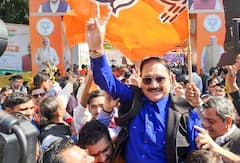Assembly Elections 2022: What Are Exit Polls? How Are They Different From Opinion Polls | EXPLAINED
An election exit poll is a survey based on interviews with voters as they exit their balloting locations. Usually, an interviewer asks the voter to fill a questionnaire.

New Delhi: The polling for the seventh and final phase of the assembly elections in Uttar Pradesh is being conducted today. With this, the assembly elections in five states – Uttar Pradesh, Manipur, Punjab, Uttarakhand and Goa – will come to an end.
ABP News has collaborated with CVoter in order to understand the perspective of people, and bring you the most accurate exit poll for the five states where the assembly elections were held. ABP News-CVoter exit poll results will be declared from 4 pm today.
What Is An Exit Poll?
An election exit poll is a survey based on interviews with voters as they exit their balloting locations or polling booths. A sample of the smallest voting units in a particular constituency is drawn, and at least one interviewer is assigned to each sampled location on the polling day, in order to estimate the outcome of the election in that constituency.
The interviewer, on a pre-determined and systematic basis, approaches people who have already voted. For instance, depending upon the expected number of voters at the sample location, the interviewer may approach every third or fifth person who leaves the voting location.
Usually, the interviewer hands the voter a questionnaire on a clipboard and asks him or her to fill out the questionnaire, an article published by the American Association for Public Opinion Research said. After this, the voter must fold the questionnaire up, and deposit it in a survey ballot box. The exit poll questionnaire, in most cases, is self-administered to protect the privacy of the voter and the confidentiality of the responses of every individual.
A typical exit poll questionnaire collects three types of data. The respondent is asked how he or she voted in the election. The questionnaire also collects information about a variety of attitudes held by the voter such as the issues that were important in determining their vote, and their party affiliation. Information on the demographic characteristics of the voter such as their age, gender, race and level of education is also collected, the article said.
Information on the voters’ attitudes and demographic characteristics are important because they can be used to explain why the respondents voted as they did and what kinds of people voted for each candidate. The exit poll questionnaires typically consist of less than 25 questions and take less than five minutes to complete.
When people are interviewed as they leave their voting place, the problem of misreporting is overcome. Respondents often misreport whether they have voted or not when interviewed over the telephone, the article said.
Analysts have sophisticated statistical models to make projections which use additional data beyond that gathered in the exit polls, including historical voting data such as past turnout, the article said. As the exit poll results become available, computer models use this information to evaluate the exit poll results. The models look at whether the turnout is higher or lower than usual.
After the votes have been counted, the exit poll results are adjusted to match the actual election outcome, the article said. In this way, the final exit poll data can be used for its most important purpose, which is to shed light on why the election turned out the way it did. These data are important because they provide powerful explanations to why people voted the way they did, the article said. People also get to know which key demographic groups voted for which candidates and why.
The exit polls do something which pre-election polls cannot do – exit polls capture the intent of last minute deciders.
How Are Exit Polls Different From Opinion Polls?
An opinion poll is a pre-election survey that is conducted to find out public opinion before the elections. The pre-election survey gathers voters' views on a wide array of election-related issues.
Meanwhile, an exit poll is a post-election poll conducted just after a person walks out after casting his or her vote. The voters are asked who they voted for.
The people included in an opinion poll may or may not vote. The participants in an exit poll are the ones who have already voted.
Both exit polls and opinion polls have certain drawbacks. For instance, in case of an opinion poll, people may change their opinion after participating in the survey. Also, there is a possibility that some participants do not cast their vote on the day of polling. Some participants may lie, and non-registered voters may also be included in the poll.
Meanwhile, in case of exit polls, certain people may not be interested in revealing who they voted for.
The first known example of an opinion poll was in 1824, when the Raleigh Star and North Carolina Gazette and the Wilmington American Watchman and Delaware Advertiser reported tallies of voter preferences prior to the 1824 Presidential Elections in the United States.
Warren Mitofsky, an American pollster, conducted the first major exit poll. In November 1967, he devised an exit poll for the CBS News, during the Kentucky gubernatorial election.
The results for the assembly elections in Uttar Pradesh, Uttarakhand, Manipur, Goa, and Punjab will be declared on March 10.
Related Video
Navi Mumbai Civic Polls: Shiv Sena and BJP to Contest Separately, No Alliance Announced

































